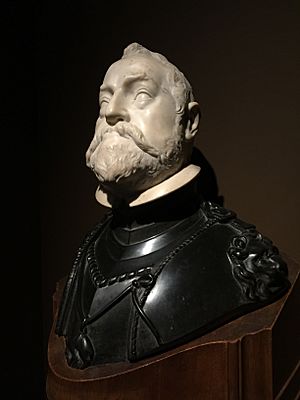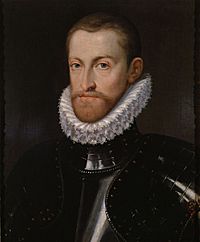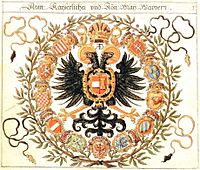Rudolf II, Holy Roman Emperor facts for kids
Quick facts for kids Rudolf II |
|
|---|---|

Portrait by Hans von Aachen
|
|
| Holy Roman Emperor (more...) | |
| Reign | 12 October 1576 – 20 January 1612 |
| Proclamation | 1 November 1575, Regensburg |
| Predecessor | Maximilian II |
| Successor | Matthias |
| Born | 18 July 1552 Vienna, Austria |
| Died | 20 January 1612 (aged 59) Prague, Bohemia |
| Burial | St. Vitus Cathedral |
| Issue | Don Julius Caesar d'Austria (ill.) |
| House | Habsburg |
| Father | Maximilian II, Holy Roman Emperor |
| Mother | Maria of Austria |
| Religion | Catholicism |
| Signature | |
Rudolf II (born 18 July 1552 – died 20 January 1612) was a powerful ruler in Europe. He was the Holy Roman Emperor from 1576 to 1612. He also held titles like King of Hungary and Croatia (as Rudolf I), King of Bohemia, and Archduke of Austria. Rudolf was a member of the important House of Habsburg family.
People remember Rudolf II in different ways. Some say his choices led to a big war called the Thirty Years' War. Others see him as a great supporter of Mannerist art, which was a unique style. He was also very interested in mysterious studies like astrology and alchemy, which were seen as science back then. Rudolf wanted to unite all Christians and started a long war against the Ottoman Empire. This war, known as the Long Turkish War, tired out his people. His brother, Matthias, took over some of his power. Rudolf was also known for being fair to Judaism, allowing Jewish culture to grow.
Contents
Rudolf's Early Life and Interests
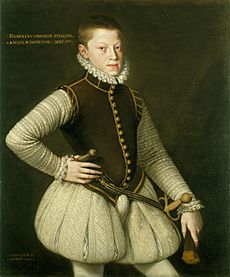
Rudolf was born in Vienna on 18 July 1552. He was the oldest son of Maximilian II, who was the Holy Roman Emperor. His mother was Maria, a princess from Spain. Rudolf had a younger brother named Matthias, who later became emperor after him.
From age 11 to 19 (1563–1571), Rudolf lived in Spain at the court of his uncle, Philip II. When he returned to Vienna, his father worried that Rudolf had become too serious and quiet, like the Spanish court. But his Spanish mother thought he was polite and refined. Before his father died, Rudolf was crowned King of Hungary (1572), King of Bohemia, and King of the Romans (1575).
For the rest of his life, Rudolf was often private and didn't like to travel or deal with daily government tasks. He was more interested in subjects like astrology and alchemy, which were popular during the Renaissance period. He also loved horses, clocks, collecting rare items, and supporting artists. Rudolf sometimes felt very sad or down, a problem common in his family. These feelings got worse as he got older, making him withdraw from the world.
Rudolf's Personal Life
Like Queen Elizabeth I of England, Rudolf never married, even though he was considered a good match for many royal families. He had several children with his mistress, Catherina Strada. Their oldest son, Don Julius Caesar d'Austria, was born around 1584–1586. Rudolf made sure Julius received a good education.
Rudolf became emperor after his father in 1576. In 1583, he moved his main court to Prague. His son Julius later lived at Český Krumlov Castle, which Rudolf bought. Julius died young in 1609 after a difficult life.
Rudolf's Time as Emperor
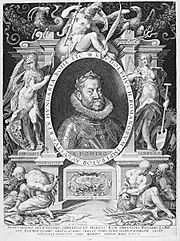
Some historians used to say that Rudolf's interest in art and mysterious studies caused problems during his rule. But more recently, historians see his support for art and early sciences as a great achievement of the Renaissance. They believe his political challenges came from trying to unite a Christian empire during a time of big religious and political changes.
Even though he grew up in a Catholic court, Rudolf was open to different religions, including Protestantism and Judaism. Because of his fair policy, Jewish culture and population grew during his reign. He didn't strongly support either Catholics or Protestants, which sometimes led to political confusion.
His biggest challenge was a long war with the Ottoman Empire. Rudolf was determined to start a new Crusade to unite all Christians. This led to the "Long Turkish War" in 1593, which lasted until 1606.
By 1604, his Hungarian subjects were tired of the war and started a revolt led by Stephen Bocskai. In 1605, his family made him give control of Hungarian affairs to his younger brother, Archduke Matthias. Matthias then made peace with the Hungarian rebels and the Turks.
Rudolf was angry about these peace agreements, thinking Matthias gave away too much power. Rudolf wanted to start another war with the Turks. But Matthias gained support from the Hungarians and forced Rudolf to give him the crowns of Hungary, Austria, and Moravia. At the same time, Protestants in Bohemia asked for more religious freedom, which Rudolf granted in a document called the Letter of Majesty in 1609. When the Bohemians kept asking for more, Rudolf tried to stop them with his army.
The Bohemian Protestants then asked Matthias for help. Matthias's army held Rudolf prisoner in his castle in Prague until 1611, when Rudolf also gave the crown of Bohemia to his brother.
Rudolf's Death
Rudolf died in 1612. He had lost almost all his power to his younger brother, Matthias, who became Holy Roman Emperor a few months later. In May 1618, an event known as the Defenestration of Prague happened. Protestant Bohemians threw imperial officials out of a window, which helped start the terrible Thirty Years' War (1618–1648).
Rudolf's Art Collection and Support
Rudolf moved the Habsburg capital from Vienna to Prague in 1583. He loved collecting paintings and would often spend hours admiring new artworks. He spent a lot of money to buy masterpieces from famous artists like Dürer and Brueghel. He also supported many of the best artists of his time, who created works in the Northern Mannerist style. These artists included Bartholomeus Spranger, Hans von Aachen, Giambologna, Giuseppe Arcimboldo, and Roelant Savery.
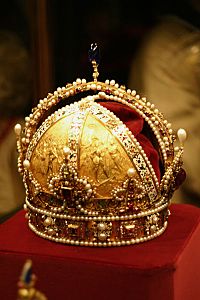
Rudolf's art collections were the most impressive in Europe during his time. The art style he supported is often called "Rudolfine Mannerism."
His love for collecting wasn't just for paintings. He ordered all kinds of decorative objects, especially mechanical moving devices. Swords, musical instruments, clocks, telescopes, and other scientific tools were made for him by Europe's best craftspeople.
He also supported natural philosophers (early scientists) like the botanist Charles de l'Ecluse, and astronomers Tycho Brahe and Johannes Kepler worked at his court. Tycho Brahe created the Rudolphine Tables, which were the first detailed tables of planet movements. Rudolf also attracted top instrument makers like Jost Bürgi. These makers worked closely with the court astronomers and had financial support to develop new scientific tools.
The poet Elizabeth Jane Weston, who wrote in Latin, was also part of his court.
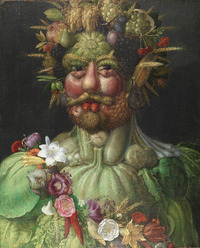
Rudolf had a collection of exotic animals, botanical gardens, and Europe's largest "cabinet of curiosities" (Kunstkammer). This special room held items from nature and human creations. It was located at Prague Castle, where Rudolf built a new wing between 1587 and 1605 to hold his growing collections.
One story says Rudolf owned the Voynich manuscript, a mysterious book whose language and purpose are still unknown. However, there's no real proof of this. The Codex Gigas, a very large medieval book, was also in his possession.
A famous portrait of Rudolf II was painted when he was 15 by Alonso Sánchez Coello. This painting can be seen at the Lobkowicz Palace.

By 1597, his collection filled three rooms. When the building was finished in 1605, the collection moved to a special Kunstkammer. Minerals and gemstones were displayed in 37 cabinets.
Rudolf's Kunstkammer was not just a random collection. It was organized like an encyclopedia. Rudolf also hired his court doctor, Anselmus Boetius de Boodt, to manage the collection. Anselmus was a keen mineral collector and traveled widely. Between 1607 and 1611, Anselmus cataloged the Kunstkammer and published a book about minerals.
The collection was private, but friends, artists, and scholars could study it. It became a valuable tool for research during the 17th century, known as the "Age of Reason."
After Rudolf died, his successors didn't care for the collection as much. Much of it was moved to Vienna. In 1648, during the Thirty Years' War, Swedish troops looted Prague Castle and took many of the best paintings. In 1782, the rest of the collection was sold off. Some items from the Kunstkammer still exist in museums today.
Rudolf's Interest in Mysterious Sciences
In Renaissance Prague, astrology (studying stars to predict the future) and alchemy (trying to turn metals into gold) were seen as real sciences. Rudolf was very interested in both. He spent a lot of money bringing Europe's best alchemists, like Edward Kelley and John Dee, to his court. Rudolf even did his own experiments in a private alchemy lab. The famous Nostradamus even wrote a horoscope for him.
Rudolf's interest gave Prague a mystical reputation that still exists today. "Alchemists' Alley" at Prague Castle is a popular place for visitors.
Rudolf's support for these mysterious sciences, along with his tolerance for Jewish people, led to the legend of the Golem of Prague.
See also
 In Spanish: Rodolfo II del Sacro Imperio Romano Germánico para niños
In Spanish: Rodolfo II del Sacro Imperio Romano Germánico para niños
- History of Austria
- Kings of Germany family tree; he was related to every other king of Germany
- Moldavian Magnate Wars for the background on southern wars (with Ottoman Turkey and its allies)
- Vespasiano I Gonzaga, a friend of Rudolf who built a Renaissance "Ideal city" in Sabbioneta, Italy
- Mineral collecting – Rudolf II was the 16th century's most famous mineral collector; his collections were curated by Anselmus Boetius de Boodt


